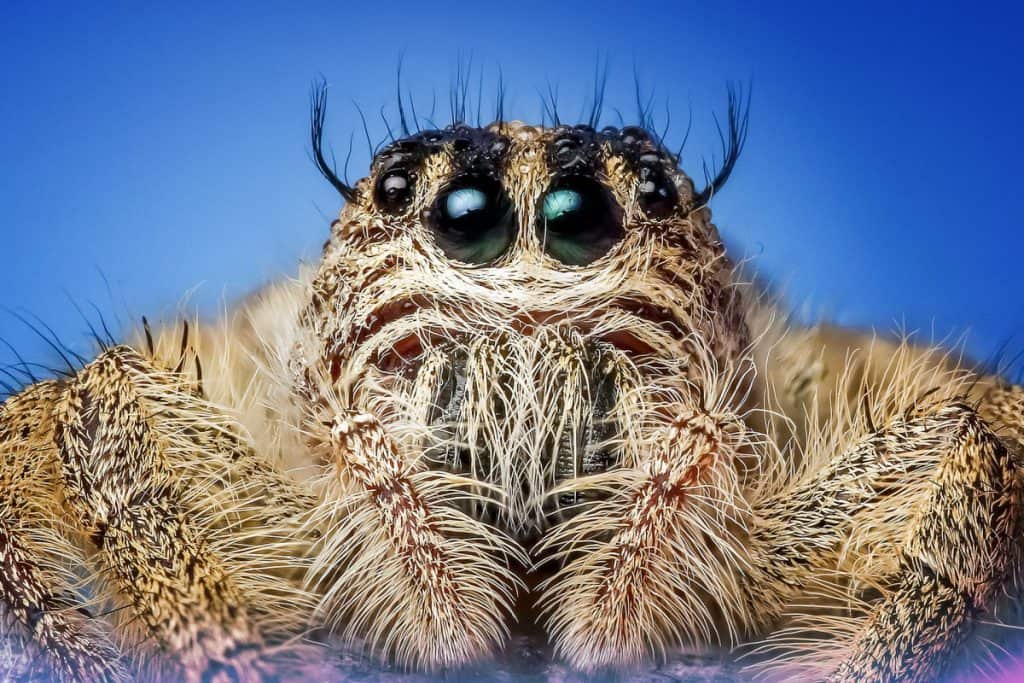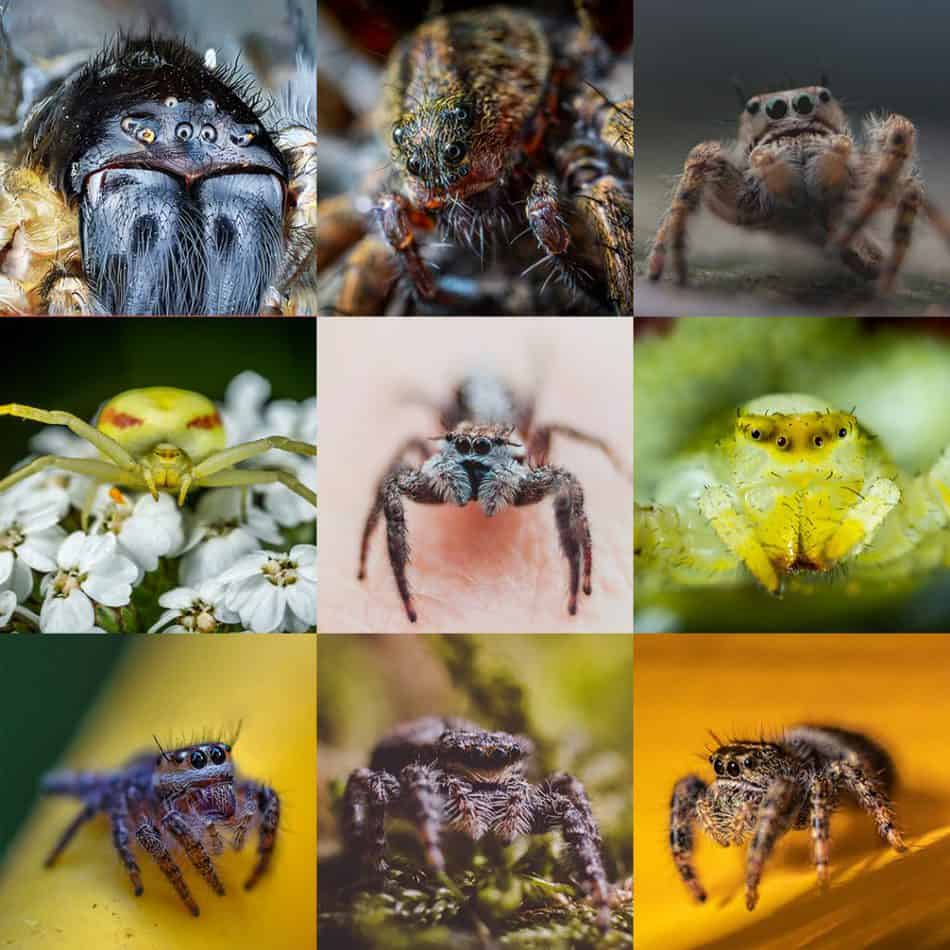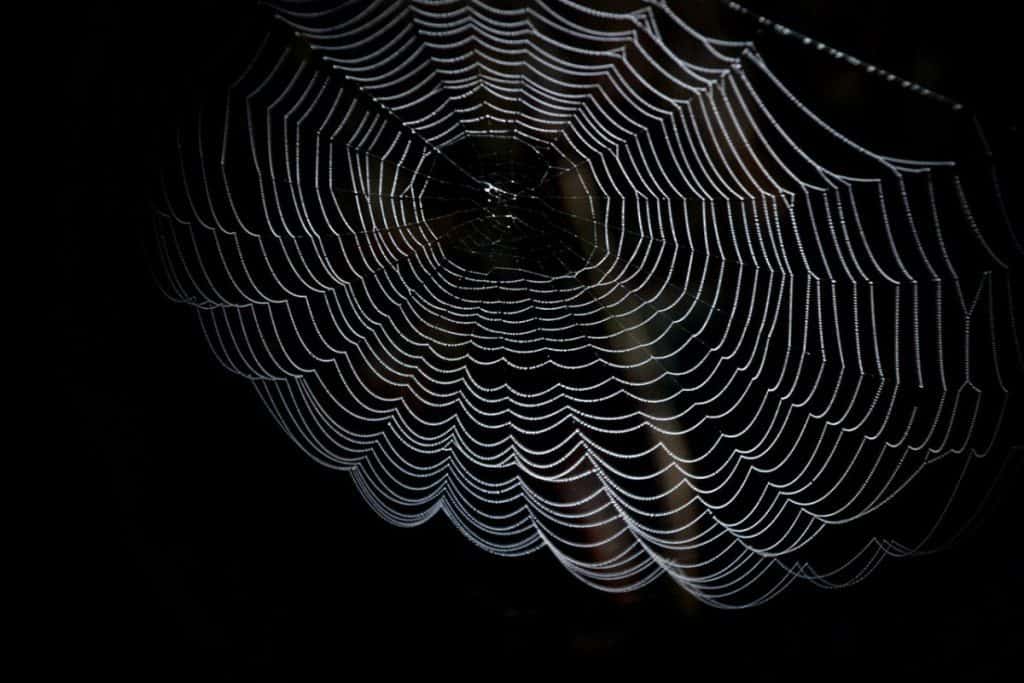If you enjoy reading this article, why not check out our articles on Can Spiders Swim? Let’s Find Out! and Do Spiders Sleep? Do They Rest?

Spiders, despite being mostly nocturnal creatures that are usually equipped with 8 eyes, do not generally see very well in the dark. They typically use their eyes to detect motion when there’s light. Instead, they rely on other senses to detect prey and obstacles in their environment.
How Well Can Spiders See In The Dark?
Most spider species may not be able to use their eyes for many things but are they capable of using them in the dark? After all, they hunt in the dark, so it’s only logical for their eyes to have some form of night-vision capabilities.
The truth is, most kinds of spiders cannot use their eyes in the darkness effectively. With some notable exceptions, most spiders have rather poor eyesight, even in the brightest of environments. Such small eyes cannot filter the world as our eyes do and so spiders have developed other methods for gathering information about their surroundings.
There is one particular kind of spider that not only has great eyesight but can even locate its prey in the darkest of places, unlike many of its spider cousins. Wolf spiders, members of the Lycosidae family, use their long legs to pounce on top of their victims and devour them. Want to learn more about Wolf Spiders? Take a look through Where do Wolf Spiders Go in the Winter?
While other spiders detect their prey’s motion through the vibrations of their webs, through smell, etc., wolf spiders will utilize their superb vision to detect their victim. They are able to do this because of the well-developed tapeta in their eyes that can absorb the moon’s light and help them see better.
Their eyes are excellent at absorbing light. So much so that if you suspect a wolf spider is hiding in the dark, you can use a flashlight to spot them – their eyes will reflect the light you shine back at you, if they happen to be looking at you.
Do All Spiders Have The Same Eyes?

Spiders come in many different sizes, colors, and hunting behaviors, not to mention that some of them are venomous and are known to attack humans as well. What most people don’t know, either, is that spiders don’t all have the same visual capabilities.
It’s common knowledge that spiders have 8 eyes. However, there are more than 40.000 different kinds all over the world, so it’s unlikely that 2 spiders will look at the world the same way.
Let’s take the jumping spider (of the Salticidae family of spiders) for example, as they are one of the most common species of spiders you can come across. This particular kind has 8 eyes, but they are grouped into 4 pairs. Some pairs are more useful for detecting the different colors of the light spectrum, while other pairs are used to detect motion and even some detail.
There are certain species of spiders that, unlike their 8-eyed cousins, have 6 or fewer eyes. In 2012, scientists discovered the Sinopoda Scurionin Laos. It’s a spider that lives exclusively in dark caves and has no eyes. This goes to show that spiders don’t rely on vision in the same way humans do.
Do Spiders Have Good Vision?

Since they move about and hunt in the dark, most species of spiders don’t have great eyesight, despite the number of eyes they possess. Generally speaking, most spiders will utilize other sensory organs to detect other spiders and prey in their immediate environment, with vision serving as a backup tool more than anything else.
That being said, however, there are some notable exceptions to this rule. The aforementioned jumping spider is one of these kinds that have an above-average vision. These acrobatic insects do most of their hunting during the daytime and this is why they evolved to be able to use their eyes for a variety of functions.
For starters, they are amazing at perceiving even the tiniest amount of motion so that they can better detect potential prey. Not only that, but their eyes also detect color. This is especially useful to a jumping spider since they use color to detect members of their species and even potential predators and other hazards.
Just because jumping spiders can get around using their eyes, however, doesn’t mean that their eyes work like ours. We discussed previously that their 8 eyes are arranged is a very particular pattern around their body, with different eyes being used for specific purposes. Depending on the eye’s size and type, the amount of stuff they can see changes but generally, most spider eyes only offer them about 2-5 degrees of vision.
Why Do Spiders Live In Dark Places?

It is not uncommon to see spiders scurrying around or waiting patiently on their webs for prey at night, only for them to disappear once the sun is up. Spiders usually retreat to a dark hiding place during the day until it is time for them to emerge and continue hunting.
But why choose a dark place when they can hang out somewhere bright and easy to access? The answer is simple: we might see spiders as terrifying, nightmarish creatures to avoid, but other animals don’t think in the same way we do. Spiders can easily become prey to birds or other insects if they are not careful.
This is why spiders prefer to keep a low profile. Why risk becoming someone else’s food when you can instead weave a silky trap and wait for the food to come to you? To reduce the chances of them being spotted, either by other animals or horrified humans, they will lay low in dark places and wait for the sun to come down to start hunting for prey.
There are other reasons that explain their preference for dark places. Spiders need to ensure the survival of their eggs as well, otherwise, the young ones may never hatch. Even in our homes, spiders will look for secluded, hard-to-reach places (like the back of furniture, basements, attics, etc.) to lay the eggs, places that will help their young stay out of danger.
Lastly, spiders don’t need warmth to function. They are cold-blooded creatures and as such, they aren’t attracted to light in any particular reason. Quite the opposite, whether we are talking about indoor spiders (like the ones we are likely to encounter in our homes) or outdoor spiders, heat probably means that they are in the light. If they can be seen, then they can be eaten, so they will avoid light if they can.
If all this information is wondering if spiders hibernate, read through our article Do Spiders Hibernate? to find out!
How Are Spider Eyes Arranged?
Most kinds of spiders have 8 eyes on their bodies. They aren’t all used for the same purposes, hence their different sizes and placement on the spider’s head. We also stated that certain kinds in the world only have 6 eyes and cave-dwelling species that have not developed any eyes since they live exclusively in 100% dark caves.
Broadly speaking, spiders’ eyes are divided into 2 categories: principal and secondary.
- The principal eyes, the ocelli (or the “little eyes”) are placed in the front and they are used to form pictures. It is with these eyes that spiders can attempt to locate other creatures through motion and gauge a subject’s size.
- The rest of the eyes are categorized as secondary. Unlike the principal eyes, spiders typically do not have muscles with which to move their secondary eyes, so these stay fixed in one place. Also, secondary eyes may be found in a row below the principal eyes, and even on the head’s side.
Secondary eyes are used to detect motion and even measure how dark a place is. These eyes can help the spiders see when there’s little light. The wolf spider’s eyes are amazing at this. On the other hand, the jumping spider operates during the day and so, its secondary eyes do not possess this ability.
Can Spiders See Colors?
There are a lot of questions regarding spider vision. There are tens of thousands of different kinds of spiders and we cannot be sure about all of them.
Since the vast majority of spiders don’t rely heavily on vision for their survival, it’s safe to assume that they do not possess eyes that have the ability to perceive color the same way humans do. But there is one thing they can do that we cannot.
Many insects, spiders included, can detect ultraviolet light emanating from the sky. Insects are particularly sensitive to this light and certain web-spinning spiders use this to their advantage. For example, the Argiope argentata weave their webs in such a way as to reflect UV light and lure other insects to their doom.
But what about colors? Are there spiders that can see the same colors as us? Let’s go back to the jumping spider. This particular species is unique (as far as we know) in that they can see pretty much the same colors we can, in addition to UV light.
| Humans | Can see the visible spectrum but not ultraviolet |
| Spiders | Can see the visible spectrum and ultraviolet |
The jumping spider has quite a colorful body and in order to attract potential mates, the male will show off these colors in an elaborate dance. Scientists theorized that if these spiders could not perceive color, then this ritual would be completely pointless.
Upon closer inspection, it turns out that jumping spiders possess eyes that can detect green, red, orange and yellow by utilizing filters inside the eyes’ retinas. These filters grant them true trichromatic vision, like humans.
If you enjoyed reading this article, why not check out our articles on What do Praying Mantis’ Eat? A Complete Guide and Longest Living Mantis Species – an Examination
Recent Posts
Tiny Black Bugs in Bathroom NO WINGS: What They Are and What to Do!
Finding tiny black bugs in your bathroom can be uncomfortable, to say the least. Especially if they are persistent, or they appear in very large numbers, which they often like to do. When it...
Tiny Black Bugs in Plant Soil - What Are They & What To Do About It
A short horror story: You get a new houseplant. You do your best to take care of it. You’ve ensured that it has the right soil, the right amount of sun, it gets enough water. And then one day, you...

